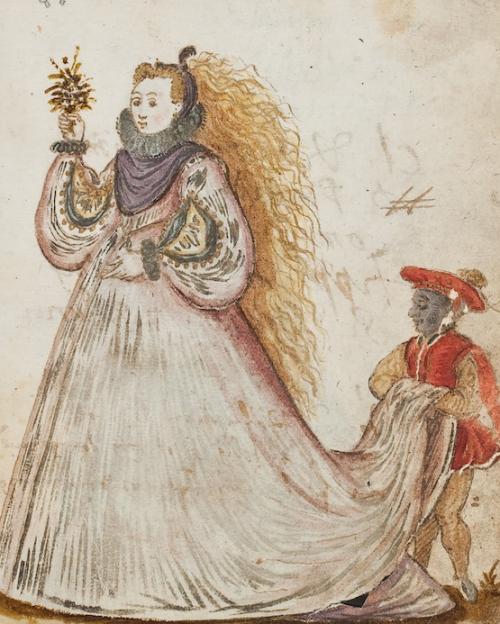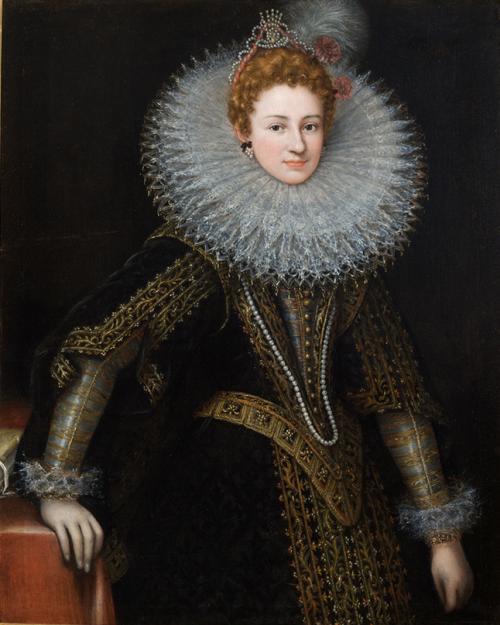While fashion magazines and social media strongly influence how people dress today, there were literally fashion police in most early modern European cities, according to art history scholar Ana Cristina Howie, with local laws dictating – down to the gold button and the color of silk – what people of various groups could and could not wear.
“You can wear silk, but only in a certain number of colors – black, white, yellow, green, dark blue, red, purple, or tawny brown,” Howie said of “sumptuary laws” local to 16th century Genoa. “You can wear wool in any of the colors silk comes in, plus fawn, white, rose, and porcelain. You can wear velvet, but not if it has any kind of pattern. It’s hard to wrap your head around what’s forbidden because it’s so detailed.”
In new research, Howie, assistant professor of history of art and visual studies in the College of Arts and Sciences, points out how sumptuary laws in early modern Genoa – designed to “control luxury clothing consumption and the social ills it could encourage” – constrained women more than they did men, even while fashion was an important means of self-expression for women, who were seen as “the silent sex,” Howie wrote.
Her research, “Sumptuary Laws, Gender, and Public Dressing in Early Modern Genoa” was published in The Historical Journal in September.
In early modern Genoa, an important center of commerce, sumptuary laws were unique, Howie said. While other cities considered class, birthplace and other categories in their sumptuary laws, Genoa’s divided the population only into men and women, making this city a key site for studying the ways the society perceived and molded ideals of gender difference through laws about dress and adornment.
For his study, Howie examined a ledger of sumptuary denouncements in Genoa for 1598. In more than 200 entries, authorities detailed how various citizens transgressed the sumptuary laws.
One entry described how the daughter of a noblewoman was stopped in Piazza San Lorenzo for wearing a yellow and mulberry silk ungaresca (sleeved jacket), Howie wrote. A nobleman was spotted in Piazza di Ponticello “dressed in a richly embroidered taffeta cassock and breeches.” Men and women were written up for wearing solid gold jewelry. Most offenders were from the noble class.

The city wanted to limit ostentatious display of wealth – but for women more than for men, Howie said. At the time, certain dyes, such as red, purple and black, were more difficult to make and therefore more costly. Similar costs were associated with precious metals.
“Being overly ostentatious was seen as a vice – gluttonous appetite for material goods. And women were seen to be more easily tempted into luxuria because of weaker constitutions, which led them more easily into temptation,” Howie said, adding that regulations for men were not even a page long; women had three times as many. “Which is part of why the articulation for feminine restrictions is so overboard. It betrays this misogynistic theological understanding of women and women’s nature, so you need more regulation to keep women under control.”
Howie is writing a book that expands on these ideas, looking at the ways in which Genoese women expressed themselves and maneuvered in their social worlds through fashion, portraiture and material culture, some of the only means available to them.
“For me, the sumptuary law dimension was foundational for this larger story I want to tell,” Howie said. “What are the fashion rules of the day that women are negotiating?”
In Genoa, the people who were making up the laws and those who were stretching the limits were all from the same small pool of about 1,000 ruling nobles, Howie said.
“There was an office dedicated to regulating luxury, comprised of the nobles who – I know because I’ve seen their inventories – are also consuming all the things they are saying are forbidden.”
Governments no longer prescribe down to the last button what people should be wearing, but Howie does see realms of modern western society in which fashion literacy still plays an important part.
“I have friends in the corporate world, for example,” she said. “Their handbag cannot cost more than their boss’s handbag because everybody knows and you’d be overstepping your rank in that way. For men, it’s watches. It’s interesting how these forms of social policing persevere.”





